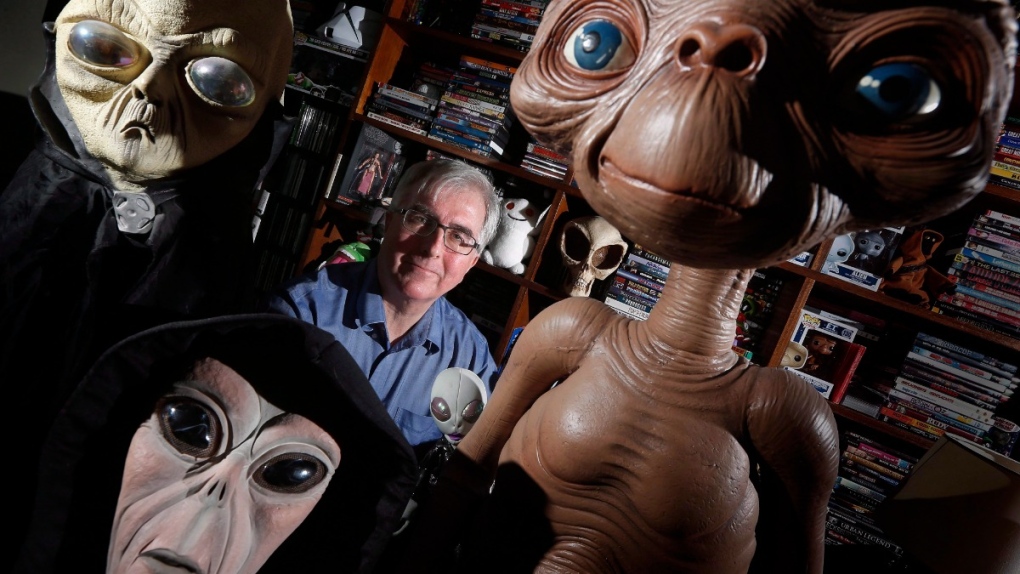
Canada’s preeminent ufologist has seen an uptick in reported sightings of unidentified flying objects in recent days suggesting more Canadians are turning their eyes to the sky after U.S. fighter jets shot down three separate objects over the weekend.
Chris Rutkowski, with Ufology Research in Winnipeg, has been collecting and analyzing Canadian data on unidentified flying objects, or unidentified aerial phenomena as it’s more recently been referred to as, for nearly 35 years.
Following the U.S. and Canadian governments “unprecedented” decision to take action against the objects, Rutkowski has received a number of sighting descriptions, including one on an Ontario highway near Cambridge where someone said they saw a “black rectangle” move across the highway.
“People are keeping a closer eye to the skies and thankfully are reporting them so that we can get some data on what people are seeing,” said Rutkowski.
Reported sightings of unidentified flying object reached an all-time high in Canada in the 2010s but have been on a steady decline since then.
Ufology Research’s latest study released earlier this month suggests there were 768 UFO sightings in the country last year — a slight increase of about six per cent from the previous year. Rutkowski found one person in Quebec reported nearly 40 separate sightings, which accounted for the higher number. The number of reported sightings in Canada last year was the fourth-lowest over the past 20 years.
The study said these numbers likely don’t show the full picture as individuals are reluctant to report sightings out of fear of being ridiculed or concern for their reputation.
But Rutkowski stresses times have changed in the field. While the mere mention of the term UFO used to conjure images of alien invasions, tin hat wearing conspiracists and pop culture extraterrestrial icons Alf and E.T., research around the phenomena has evolved in government and academic circles.
Canadians are in “good company” if they believe they’ve seen a UFO as polls conducted suggest that 10 per cent of people in the country believe they’ve seen an unidentified object in the sky, said Rutkowski.
“When a person reports seeing a UFO, whether you’re a pilot or just an average person on the street, you may be seeing something that is quite significant and potentially of value to researchers,” he added.
Chris Styles said it’s not uncommon to see an increase in reports when events like this happen but cautions it doesn’t mean there is an increase in the number of flying objects only that more people are paying attention.
“Sightings breed sightings,” said the renowned UFO researcher from Halifax.
Recent events may have Canadians changing their tune.
American fighter jets took down an unidentified object over the northern coast of Alaska on Friday, one over central Yukon on Saturday and another over Lake Huron on Sunday. The flurry of close encounters followed what officials said was a Chinese surveillance balloon that floated across the continent two weeks ago and was shot down off the coast of South Carolina.
While it’s not clear where the objects came from or who might have dispatched them, the prevailing theory at the moment is that they were “benign,” posing only a threat to passing civilian aircraft, the White House said this week.
Search efforts are underway in a remote stretch of central Yukon to locate the remnants of the object, which chief of Defence Staff Gen. Wayne Eyre said is a “suspected balloon” in a tweet Wednesday.
Government officials on both sides of the border have stated there is no indication the objects were the work of aliens or “extraterrestrial activity.”
Recent data from Google Trends points to peoples’ innate curiosity about interplanetary visitors and the world beyond Earth. On Saturday, UFOs were the third most searched topic in Canada with more than 100,000 searches. The following day it dropped down to 13th place, while the term aliens has been trending steadily in Canada’s north since Sunday.
Rutkowski said every year there are well-documented cases from “good observers” that go unexplained but it would be, “presumptuous to say those are from outer space and extraterrestrials.”
“There probably is life out there somewhere, and somewhere out there they might have developed the ability to travel between the stars…we don’t have any proof of that, but the probability is never zero.”
In academic circles the notion of studying this phenomena has been taken more seriously after details about the Pentagon’s UFO program were discovered in 2017, said Paul Kingsbury, a professor in the department of geography at Simon Fraser University.
While the U.S. has made co-ordinated efforts to document this issue, there is a disconnect on the Canadian side, Kingsbury added.
He said it’s important for the Biden administration and Canada to work transparently with the scientific community so that academics can access information and data that will help address the problem of identifying these objects.
“It would allow the public to more fully understand what these objects are, their nature, what is causing them and the consequences of the many reports of these anomalous objects in our skies.”
As Canadians continue to navigate global unrest associated with the COVID-19 pandemic, climate disasters and wars overseas, messaging shrouded in “mixed messages and mystery” can leave people feeling anxious.
“Being transparent, wherever possible, is also important for peoples’ peace of mind,” said Kingsbury.
